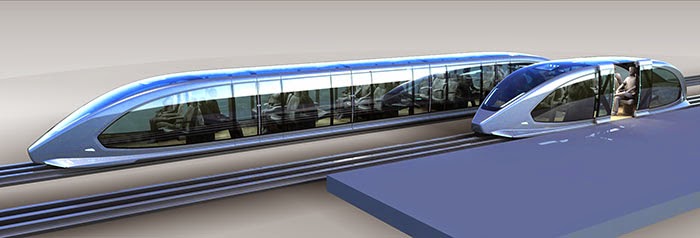How a Magnetic Bullet Train Works 1. The Electromagnetic Suspension:-We know that magnetic power is a kind of ultra-fast power and suppose we have got an electromagnet of much high power, even the heaviest things can be lifted with it provided the stuff to be lifted should have the metallic properties in it. The end product is a train made of a battery and magnets that propels itself through a coil of wire using electromagnetic force. Figure 1 depicts the final product. Figure 1: Finished Solenoid Track and Battery Train Principles Of Operation We will put two basic principles of electromagnetics and magnetism to work to create an electric train.

Here is an interesting project for kids that explores both electricity and magnetism – build a simple electromagnetic train!
This intriguing video has been making it’s way around Facebook… it’s a simple electric “train” made out of coiled copper wire and a train car comprised of a battery with magnets on both ends. It was so fascinating that we had to try it!

This project totally works as seen on the video, but there are some things to know first.
Want to see how it works?
To build this train, you will need:
- Copper Wire. We used 18 gauge, and it was perfect.
- A battery – we used AAA
- Neodymium magnets. Regular magnets are not strong enough. We purchased our neodymium magnets for our magnetic slime project. If you end up ordering some, you should definitely do that project too!
- Wire cutters

Electromagnetic Train Science Project
Safety Note: Neodymium magnets are extremely strong and definitely not for kids who put things in their mouths. In fact, this entire project is not for kids who still put things in their mouths! I store our magnets out of reach of my kids – even the bigger kids. They can be difficult to separate because of their strength and can definitely damage electronic devices. With proper supervision, though, this project is super cool and there is so much to learn! Just be safe.
Electromagnetic Train Experiment

Step 1: Create your train.
We put 4 magnets on each end of the train. One or two will work fine, but we had plenty so we used four. The original video does not mention this, but the magnets need to be placed on the battery with the poles facing opposite directions. Otherwise, the train will not work. (Just hold the magnets so that they push each other away, then stick the battery in between.)
Step 2: Make your coils.
The coils need to be wrapped pretty closely around the train. I found that wrapping the copper wire around a AA battery made nice even coils that were just the right size for the AAA battery plus the magnets. Once you cut the wire it’s kind of challenging to attach another section, so make a big long train track! I wish I had made ours longer, but I didn’t want to use up the entire 25 foot package if we were doing it wrong, so I cut it off to test it.
Step 3: Run your train!
How the Electro-Magnetic Train Works:
Electricity and magnetism are linked in a way that scientists do not completely understand. Each can create the other. If you wrap a copper wire into coils and run an electrical current through it, you will create a magnetic field. If you rotate a permanent magnet (as opposed to an item that has been magnetized) inside a coil of copper wire, you can create an electrical current.

In this project, the neodymium magnets on the ends of the battery create a bar magnet with a north pole and a south pole. When you put the train inside the coils, it causes an electrical current to flow through the copper wire, which creates a magnetic field in the section of wire coils right around the train car. This magnetic field has its own north and south poles, which push the train along the track. You’ll notice that the train will only run one direction because of it’s magnetic poles. It’s pretty amazing science!
We found that the battery runs down pretty quickly, and I’m not sure why this is. This train works really well for a demonstration, but you’ll probably need a fresh battery each time you get it out.
You can find a much more in-depth explanation of the science behind this project at Skulls in the Stars. He also has some very helpful diagrams in this article. Older students could benefit from drawing their own copy of the diagrams.
Be sure to visit the other posts in the STEAM Power series! So many fun ideas this week.
Simple Electric Circuit from What Do We Do All Day?
Rubber Band Car from All for the Boys
Learn and Play with Springs from Left Brain Craft Brain
Lego Inspired Electric Play Dough from Lemon Lime Adventures
Mason Jar Solar Lights from Tinkerlab
Design Thinking and Building Empathy from Meri Cherry
Tiny Dancers – Homopolar Motors from Babble Dabble Do
16 Comments
Post a CommentThanks for the helpful explanations! We've been watching the video a lot and it helps to have the insight of someone who has tried it.
Reply
thank you so much for this project i needed to do something like this
Reply
No way! That is so cool!!! My kids will love this. I love seeing it in action in the video. Super super cool. Thanks for sharing!
Reply
I've been wanting to try this! Thank you for all of the clear steps.
Reply
This looks like a great science project for my younger brothers! They are going to have so much fun building a train like this! Thanks for the project!
Reply
Okay, here are some troubleshooting ideas!
- Make sure that your wire coils are close to the 'train.' In other words, the coils should not be much larger than the train.
- Make sure that the poles of your magnets are facing in opposite directions.
- Try a fresh battery.Let me know if it still does not work!
Reply
Reply
Yes
Reply
Reply
It is important to use bare copper wire. Just stating it explicitly.
Reply
I understand that it works with only bare copper wire, and I get why it has to be bare, but could you please explain what properties does copper specifically have that makes it ideal for this experiment?
Do lemme know ASAP please.
Thank you!Reply
What a super fun idea and project to do with little ones. I love any activity that sparks an interest in electricity. Many don't think of it as a career option, but introducing your little ones to it early might be a great path for them. Thanks for sharing!
Reply
Reply
thanks
I could help my friend because of thisReply
Reply
What size neodymium magnets did you use? (The link to Amazon you provided no longer works.)
Reply
O thank you so much it will help me alot for my science project. Very nice explained
Reply
Reply
will it work if the coil is a bit loser or if the coil is a bit deformed?
Reply
We are having a very hard time making the coil the right size? Using a dowel makes it too small. How did you make the coil using only the battery? Do you have any advice?
Reply




